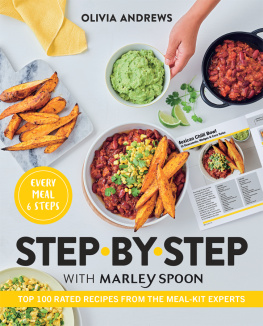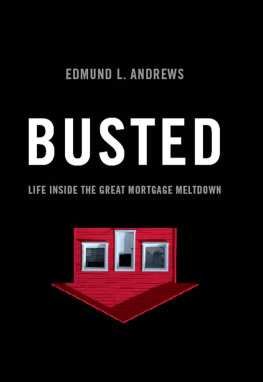Making European Breads
Glenn Andrews
Introduction
The breads of Europe are wonderful! Theyre honest, healthful, and greatly loved around the world. These days you can find a variety of European breads not only at bakeries but also at your local grocery store.
Youll find two important chapters immediately following this introduction. The first gives detailed instructions for basic bread-making techniques, and the second describes the ingredients used. Please read these sections carefully before you begin, and refer back to them as you bake (unless youre already a semipro at bread making) the recipe instructions will assume that you know the information contained in the techniques section (below).
After the actual bread recipes, youll find some great ideas for using what youve made Bruschetta, Garlic Gorgonzola Bread, Alpine Sandwiches, American Fondue, Italian Bread Salad, and many others.
Have fun!
Basic Breadmaking Techniques
Many of the same techniques are used for making different kinds of yeast breads. The most basic steps include proofing, combining the ingredients, kneading, rising, shaping, baking, and cooling.
Proofing. Proofing has two functions: It activates the yeast, and its a way to be sure that the yeast is still good (it may have expired while on the store or kitchen shelf). To proof your yeast, stir it into warm (95110F) water, usually along with a little sugar (the exact amount will be specified in each recipe). Allow the mixture to sit for five minutes, or until it is foamy. If the mixture does not foam after five minutes, then you know that your yeast is no longer active throw it out and start again with a fresh supply.
Combining the ingredients. Mixing is done differently for different breads, so refer to the individual recipes for complete instructions. However, if you are using a food processor to combine the ingredients and knead the dough, put all of the dry ingredients into the bowl first and mix them well before adding and processing the other ingredients.
Kneading. Heres where you finish up the combining process and give your bread texture. Many bread bakers do this in a food processor, pulsing off and on until a nice dough is formed, then giving the dough a final turn or two by hand.
Traditional kneading is done by hand on a floured board. Keeping your hands well-floured, form the dough into a pancake shape. Use the heels of your hands to push the dough away from you. Then fold the dough over and rotate it a quarter turn. Keep doing this, adding more flour to the board and your hands as necessary, until the dough is elastic and has lost its stickiness. A proper dough has been accurately described as feeling like a babys bottom! (Doughs containing rye flours, however, will always seem a little sticky.)
Rising. After the dough has been kneaded, place it in a greased bowl and rotate it until the dough is greased on all sides. Cover the bowl with a damp towel and let it sit in a warm place (between 80 and 85F, preferably) until the dough has roughly doubled in size (usually about an hour). A gas oven with a pilot light is often the perfect temperature for rising. If you have an electric oven, maintaining the proper temperature may be difficult. The best way to achieve the proper temperature for rising is to keep the heat in the oven off, boil a pan of water and place it on the lower rack of the oven, and put the covered bowl on the higher rack.
The dough of yeast breads will often need to rise more than once. See the recipe instructions for the appropriate number of rising times.
Punching down. Punching down is the more emphatic term for deflating risen dough. Just bang your fist into the center of the risen dough this is fun! A thorough punching down also involves turning the dough out of the bowl onto a floured board and kneading it just a few turns.
Shaping. Before it can be baked, the dough needs to be shaped into a loaf form. For an elongated loaf, flatten the dough into a rectangle; the shorter end represents the length of the bread you want or the pan youre using. Roll up the dough tightly from this short end, then pinch the ends and tuck them under.
Baking. Breads can be baked on baking sheets or, if theyre in pans, right on the ovens racks. But, especially for French bread, focaccia, or any other free-form bread, it really is nice to use a baking stone, which approximates an authentic bakers brick oven. These are rather expensive, though. You might want to try an easy substitute: Purchase some unglazed terra-cotta or quarry tiles from a store that sells ceramic tile. Theyre usually inexpensive, and come in 6-inch squares if you buy nine of them, youll have an area 18 inches by 18 inches, about the size of a baking stone, and youll have spent about one-sixth as much money. Use these tiles to line a regular oven rack and bake your bread on top of them.
Testing for doneness. The classic way to find out if a loaf has baked long enough is to remove it from the pan and rap it with your knuckles. If the bread sounds hollow, its done.
Finishing the bread. Sometimes its nice to rub the top of a warm baked loaf with a little soft butter or milk. With or without that final touch, put the finished loaf on a rack until its completely cool. If the bread was baked in a bread pan, let it cool in the pan for about 15 minutes before removing the loaf and setting it on the rack.
Keeping bread on hand. When the bread is thoroughly cool, put it into a plastic bag. Keep it at room temperature for immediate use or freeze it for later use. Bread can be frozen and thawed any number of times but if you want the bread sliced, its best to do so before you freeze it.
Using the Best Ingredients
Its truly amazing how such a limited number of ingredients can turn out so many different and wonderful breads. The quality of ingredients you use can make the difference between spectacular breads and those that are just ho-hum. So go for the best!
Flour. Ideally, you should try to find whole-grain flours (including cornmeal) that are freshly milled. If youre lucky, youll have a local food co-op or health-food store that grinds different types of flour in-store and keeps them refrigerated. Otherwise, buy the best brands you can find. White flour (also called all-purpose) can be unpredictable. If possible, use flour that is labeled bread flour, which will be especially rich in gluten, an important ingredient for high-rising breads. Other than bread flour, by far the best flour to use is unbleached white, but measuring the proper amount to use is sometimes difficult. Start by using a little less than the recipe calls for, then keep adding more, spoonful by spoonful, until you get a proper dough (see page 3 for a description of a proper dough).
Yeast. Long ago, yeast was only available in cake form. Today, youll find cakes of yeast occasionally, but usually what youll see is called active, or dry, yeast. You can buy it in packets from your local grocery store or in bulk at health-food stores and co-ops. Theres also Rapid Rise yeast, which seems very vigorous. (Ignore the package instructions and use it just as you would any other dry yeast.) One package of dry yeast contains about 2 teaspoons.
Liquid. Use the liquid called for in the recipe instructions but if youre feeling inventive, you can experiment with other liquids such as beer or orange juice. Water is the most common liquid used in European breads, but be sure its good clean water. If you have to buy bottled springwater to ensure purity, its worth the cost to avoid any off tastes that impure water may impart to your finished bread.







